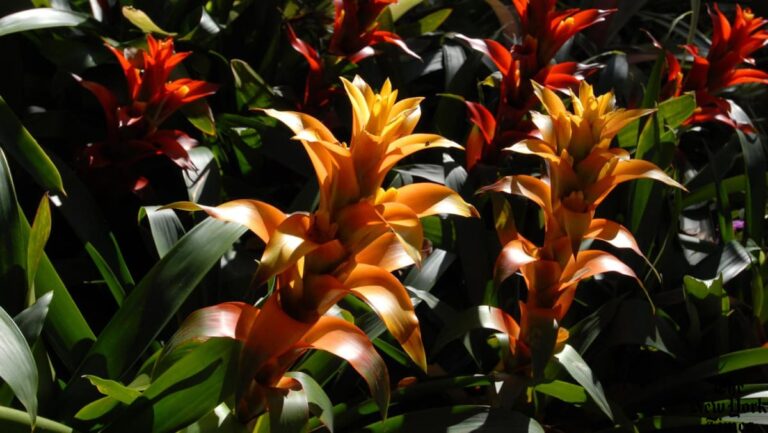CARE AND FEEDING
Owing to their epiphytic nature, most bromeliads don’t want soil a lot as a stable footing – one thing to seize onto, the way in which they might a tree within the forest cover. Those who do get potted up, just like the Cryptanthus, Guzmania or Aechmea, are greatest underpotted, or given pots which will seem like too small. This will create the look of a mismatch, nevertheless it retains roots more healthy.
“The Bromeliaceae ought to have what we seek advice from as ‘a little bit pot and a giant head,’ as a result of should you’re doing the other, you’re going to rot that plant,” Lara mentioned. Letting crops stand in a saucer of water will do the identical.
He recommends utilizing a potting combine labeled for Phalaenopsis orchids, that are additionally epiphytic. Such blends are sometimes heavy on the bark and will include elements like sponge rock, coarse perlite and charcoal.
When you have bromeliads grown in pots, water them as you’d every other potted plant. If a plant’s leaves kind a tank – the way in which Aechmea, Vriesia, Guzmania and Neoregelia do – add water into it, too.
Cryptanthus, for instance, don’t have such water-holding reservoirs.
“I don’t need to refill this factor,” Lara mentioned of the earth stars, as a result of their leaves don’t kind a tank. “I simply need to water the pot, which we’re all used to doing.”
Misting is commonly advisable as one of the simplest ways to water bromeliads grown naked root. However with Tillandsias particularly, Mr. Lara prefers dunking them in a bucket of water for an intensive soak. That could be needed solely each few weeks, or as soon as a month within the low-light winter season.
Counting on misting alone, he mentioned, you threat cultivating “zombie Tillandsias” – silvery ghosts that one way or the other proceed to look good months after their demise. Oops.
Additionally vital: Water Tillandsias within the morning somewhat than at evening. “The crops are actively doing work at evening, opening their stomas,” he mentioned. “In case you dunk them in a bucket of water, you’re just about waterboarding them, and they’re going to drown.”
After dunking a plant, enable it to empty correctly, the wrong way up, on a serviette or towel earlier than returning it to its upright rising place.
With the tank varieties, rinse the central reservoir within the sink or bathe to flush out any water that may in any other case grow to be stagnant and will rot the plant. “In case you can dump out that water and add new, that’s ideally suited,” he mentioned.
With both watering methodology, as soon as a month, from spring to fall, add balanced liquid fertilizer to the water at half energy.
“Within the forest, the crops depend on the bugs residing in that large cup and the leaf matter that’s falling, the pure elements which can be breaking down,” he mentioned. “For us, it’s fertilizer.”
What in all probability startles starting bromeliad growers most, even after offering diligent care, is the inevitable decline of the unique or mom plant after it flowers. Don’t panic: That is a part of the bromeliad life cycle.
Pups – new progress generally known as ramets – ought to be growing alongside the unique plant.
“That dying plant is giving all its sources to the brand new ones,” Lara mentioned.
Gnarly as it might search for a time, don’t rush to bid the previous plant farewell. Wait till the ramet reaches a 3rd of the mom’s measurement. Then it’s protected to take away the mom, or take away the offset and make a brand new house for it.
“And even higher,” he mentioned, “give it to a pal.”
By Margaret Roach © The New York Instances Firm
The article initially appeared in The New York Times.



